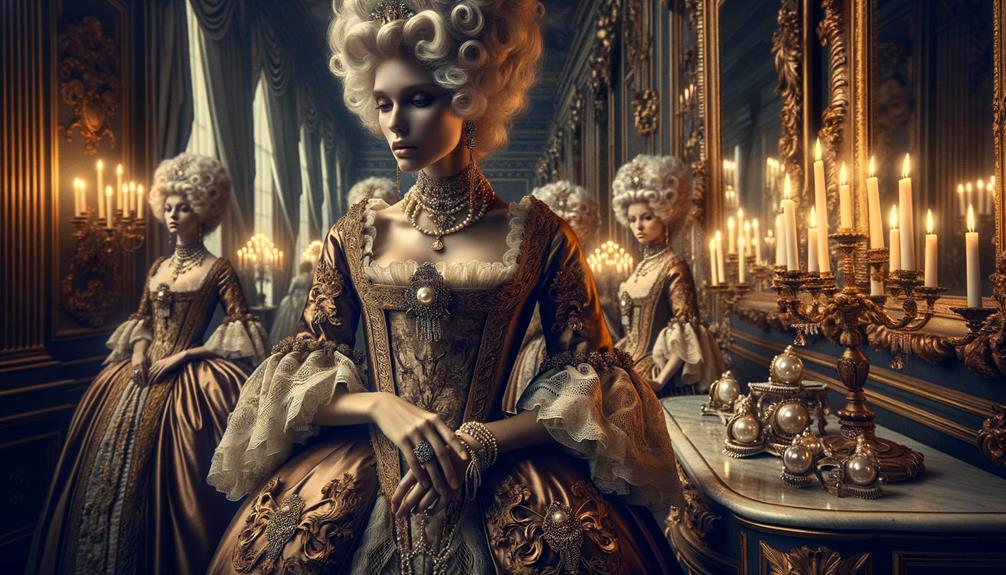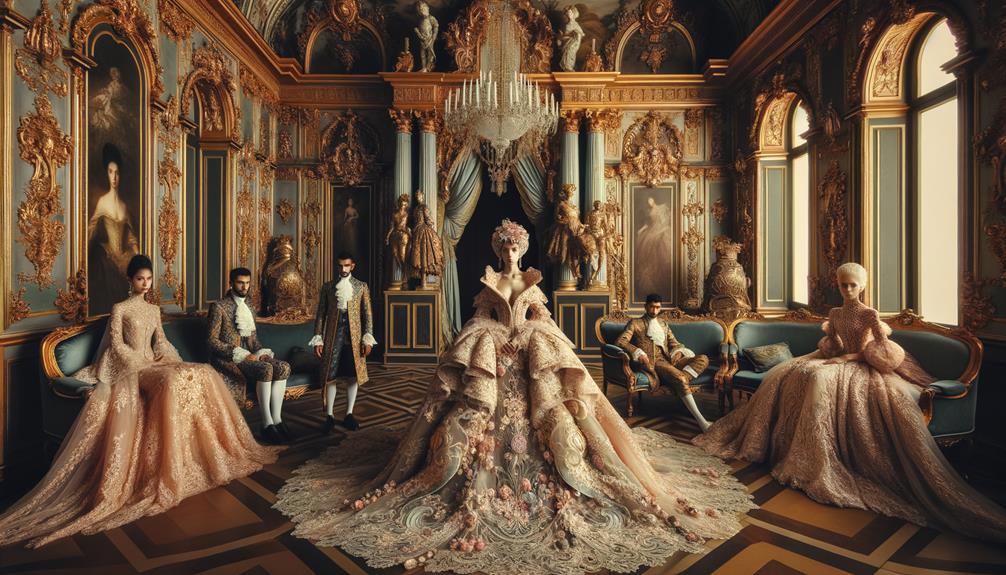17th-century European fashion was a fascinating reflection of the era's values and hierarchies. Baroque style was defined by lavish fabrics, intricate embroidery, and dramatic silhouettes. These elements weren't just about appearances – they were powerful statements of wealth and status.
Consider the exaggerated hourglass figure and elaborate accessories like ruff collars and jewel-encrusted pieces. They tell us much about the priorities and social structures of the time. The opulence of Baroque fashion was more than just extravagance – it was a visual expression of power and identity.
While some may dismiss it as mere excess, examining these extravagant trends can provide valuable insights into 17th-century European society and culture. The way people dressed was deeply intertwined with their position and influence. Fashion was a canvas for displaying status and prestige. Understanding this context can shed light on the motivations and preoccupations of the era.
Origins of Baroque Fashion
Baroque fashion emerged in 17th century Europe, reflecting the era's obsession with lavish ornamentation. The opulent court cultures of France, Italy, and Spain played a pivotal role in shaping this fashion trend.
Luxurious fabrics like silk, satin, and velvet were central to the Baroque style. These materials were chosen not just for their sheen, but for their ability to showcase intricate embroidery, lace, pearls, and precious stones. Each stitch and embellishment conveyed a sense of wealth and power.
The Baroque silhouette was equally grand, emphasizing an exaggerated hourglass figure through structured bodices and wide skirts. Densely layered fabrics added volume and a sense of grandeur. The meticulous construction of these garments aimed to create an aura of splendor.
Accessories were no less extravagant. Towering wigs and flamboyant headdresses became symbols of status, often adorned with ornate jewelry. These elements combined to produce a look that was both flamboyant and meticulously detailed. The origins of Baroque fashion lie in this blend of luxury and dramatic presentation, reflecting the essence of the period.
Key Characteristics
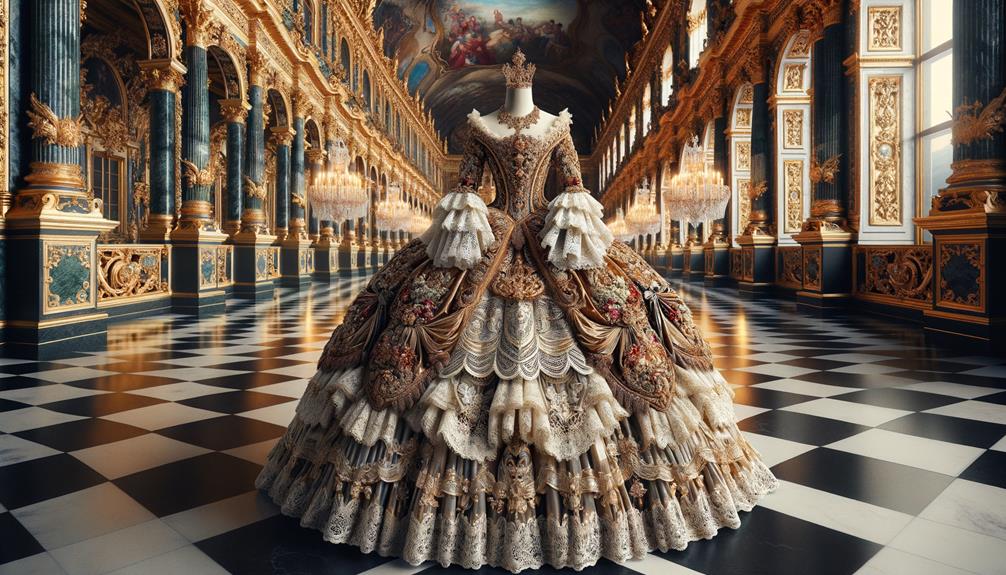
Baroque fashion was defined by its opulence and exuberance. The key characteristics included lavish fabrics, intricate embellishments, and dramatic silhouettes. This era embraced luxurious materials like silk, velvet, and brocade, creating a sense of grandeur. Clothing was not just functional; it was a statement of wealth and power.
Garments were ornamented with elaborate embroidery, lace, and pearls, reflecting meticulous craftsmanship. These details were symbols of status, not mere decorations. The high-waisted silhouettes and use of corsets accentuated the hourglass figure, enhancing the theatricality of the attire.
Ruff collars added another layer of extravagance, framing the face with intricate lace. Loose-fitting garments provided a striking contrast to the fitted bodices, while dramatic coats, waistcoats, and breeches defined men's fashion. This style was about emotional expression and the glorification of power, not just clothing.
The aesthetic of Baroque fashion was a reflection of its time – opulent and exuberant, with every element designed to impress. In a world where appearance conveyed authority, the luxurious and heavily ornamented attire spoke volumes about one's place in society.
Iconic Garments
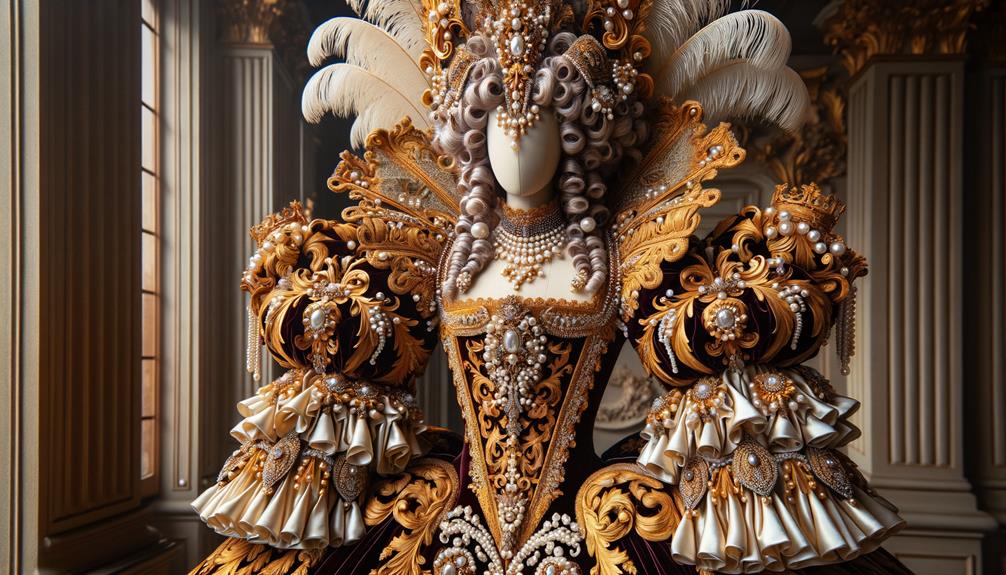
Some of the most famous outfits from the Baroque period include the elaborate ruff collars and intricately embroidered waistcoats. These pieces were lavishly decorated, showcasing luxurious fabrics like silk, velvet, and brocade. Intricate needlework adorned these textiles, often with lace, pearls, and precious stones, creating a sense of drama and grandeur.
Men's fashion featured exaggerated silhouettes with elaborate coats, waistcoats, and breeches. The high-waisted dresses of women, cinched by corsets, gave an exaggerated hourglass figure. This emphasis on dramatic shapes and forms was a hallmark of Baroque fashion, designed to captivate and impress.
Symmetrical patterns were prevalent, both in clothing and in the era's ornate furniture, indicating a preference for order and balance. Lavish elements, such as intricate lace and lavish embroideries, added to the garments' overall sense of opulence.
Baroque fashion was more than just clothing; it was an art form that embodied the extravagance of the time. Each piece was crafted to evoke a sense of awe, a visual manifestation of the era's opulent spirit. This focus on creating a striking visual impact remains influential even today.
Influential Designers
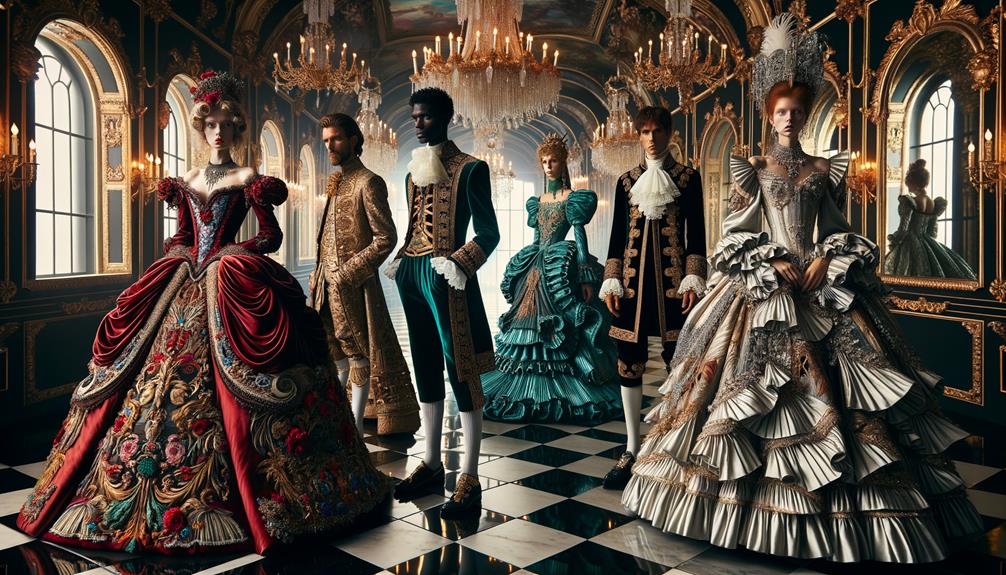
When I reflect on Baroque fashion, I can't help but marvel at the visionary minds behind its most iconic creations. Designers like Buontalenti and Le Brun didn't simply make clothes; they crafted exquisite works of art. Their use of sumptuous fabrics and architectural elements transformed garments into dramatic masterpieces that captivated audiences.
Visionary Creative Minds
Inspired by the lavish, theatrical qualities of Baroque art, visionary designers crafted garments that mirrored the era's opulence. Their creations were defined by extravagance and exuberance, featuring rich fabrics and intricate embroidery. These designers embraced exaggerated silhouettes, capturing dynamic movement and interplay of light and shadow in their work.
The vibrant paintings of Peter Paul Rubens, teeming with luxurious textiles and ornamentation, epitomized this approach. His use of lavish materials and complex embroidery set a benchmark. Dramatic silhouettes drew the eye, echoing the dynamic movement found in his scenes.
Gian Lorenzo Bernini's sculptures, notable for their fluid forms and swirling drapery, further influenced Baroque fashion. The energy and complexity in his works translated into garments that moved with the body, creating a sense of life and vigor.
Rembrandt van Rijn's chiaroscuro technique highlighted opulence through light and shadow, playing on rich velvets and brocades. His portraits, like that of Marten Soolmans, showcased the grandeur of the era.
Contemporary digital artists like Mueo and Caro draw from these Baroque elements, using intricate patterns and dynamic lighting to evoke a sense of timeless extravagance and exuberance. Their work continues the legacy of Baroque opulence, merging historical inspiration with modern innovation.
Iconic Baroque Creations
Despite the passing of centuries, Baroque fashion's iconic creations by influential designers still captivate audiences with their grandeur and meticulous detail. Charles Le Brun, a visionary of his time, crafted designs for Louis XIV's Versailles that epitomized the Baroque ethos. His creations radiated extravagance and opulence, showcasing intricate embroidery and lavish fabrics.
Madame de Pompadour, a pivotal figure in the Rococo style, pushed the boundaries of Baroque fashion further. Her patronage led to garments adorned with delicate lace and pastel hues, blending intricate details with a softer, more decorative arts approach. The Rococo style, though an evolution, still held the essence of Baroque's extravagance.
Peter Paul Rubens, known for his dynamic Baroque art, also ventured into fashion. He designed opulent costumes for the aristocracy, combining rich fabrics and extravagant accessories, reflecting the same vibrancy found in his paintings.
Giovanni Battista Gaulli contributed by designing ecclesiastical vestments with intricate gold embroidery, emphasizing the Catholic Church's power and wealth. The influence of Baroque fashion wasn't confined to Europe. Russian imperial robes, with their blend of Slavic motifs and Baroque grandeur, exemplified this global reach.
Social and Cultural Impact
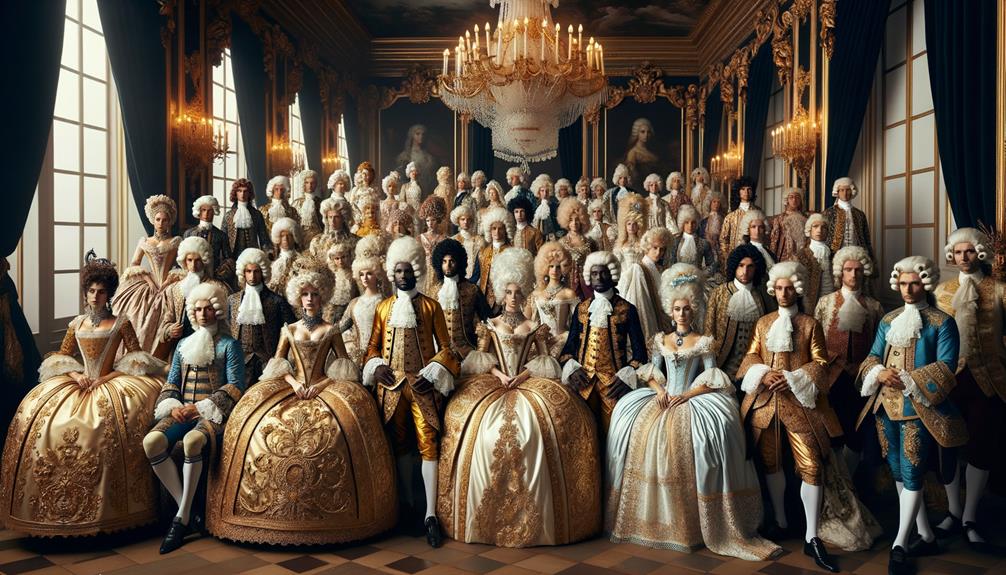
Baroque fashion was more than just clothing – it was a powerful statement about wealth and faith. The aristocracy used it to flaunt their riches, while the Church saw it as a tool to influence religious beliefs. This interplay between luxury and symbolism made Baroque fashion a vivid form of artistic expression.
The aristocracy flaunted their wealth through Baroque fashion, showcasing their lavish lifestyles. Meanwhile, the Church recognized the potential of Baroque styles to sway religious beliefs and strengthen its influence. This back-and-forth between materialistic display and spiritual messaging turned Baroque fashion into a vibrant artistic medium.
Influence on Aristocracy
Baroque fashion was more than just clothing; it was a powerful statement of aristocratic status and authority. The wardrobes of Europe's nobility were a testament to their wealth and influence, showcased through sumptuous fabrics, intricate embroidery, and lavish accessories. The exaggerated silhouettes, high waistlines, and full skirts conveyed an air of opulence, while oversized wigs added a dramatic flair.
Luxury textiles like silk and velvet, along with detailed needlework incorporating gold thread and floral patterns, were hallmarks of the aristocratic wardrobe. Extravagant adornments such as jewels and feathers further emphasized the grandeur of these garments.
The brocaded gowns and coats worn by French and Spanish royalty reflected their lavish lifestyles. These items seamlessly integrated with the magnificence of Baroque palace architecture and interior design. The courtly life was steeped in elaborate costumes and rituals, reinforcing the social hierarchy and political power structures.
This fashion was not merely for aesthetics; it was a strategic tool. Monarchs used these displays of opulence to assert their divine right to rule, projecting an image of absolute authority. The grandeur of Baroque fashion became an integral part of how royalty communicated their dominance and controlled their public image.
Religious Symbolism
Religious symbolism in fashion transformed clothing into a medium for expressing faith and devotion. During the Counter-Reformation, the Catholic Church harnessed the power of opulence and extravagance, embedding religious imagery into every stitch and seam. Sacred vestments inspired long, trailing gowns for women, while clerical ruffs found echoes in the stiff, structured collars worn by men.
Cross motifs, angels, and other religious symbols adorned these garments, turning fashion into a form of devotion. The exuberance of Baroque fashion mirrored the ornate decoration seen in churches and cathedrals, making a bold statement of faith that was hard to ignore. The Catholic Church's strategy was clear: use the splendor of art and fashion to impress and convert the masses during a time of religious upheaval.
Jewels, gilding, and elaborate embroidery weren't just decorative; they were declarations of piety and allegiance to the Church. Each element of Baroque attire served a dual purpose – exuding opulence while reinforcing religious devotion. This blend of extravagance and symbolism in fashion was a powerful tool for the Catholic Church, reflecting its resilience and adaptability in an era of significant change.
Artistic Expression
Fashion during the Baroque era was more than just clothing – it was a vivid display of social hierarchy and cultural dynamism. The style mirrored the opulent artistic expression seen in Baroque painting and sculpture. Artists used elements like light and shadow to create dramatic effects and a sense of movement, which was echoed in the elaborate garments of the time.
Baroque fashion and art were intertwined, each influencing the other. The use of lush fabrics and intricate embroidery in clothing paralleled the detailed brushstrokes and rich textures in paintings. This period saw clothing becoming a canvas for artistic expression, enabling a visual dialogue between different art forms.
The wide-hipped dresses of the era evoked a sense of power and drama. Voluminous wigs created an imposing silhouette, much like the towering architecture of the time. The use of precious gems and metals in attire hinted at the divine right of monarchs. The sumptuous fabrics of silk and velvet conveyed luxury and status.
In essence, Baroque fashion was an artistic creation in itself. Every element was designed to project authority and magnificence, much like the art that flourished during this exuberant period.
Modern Interpretations
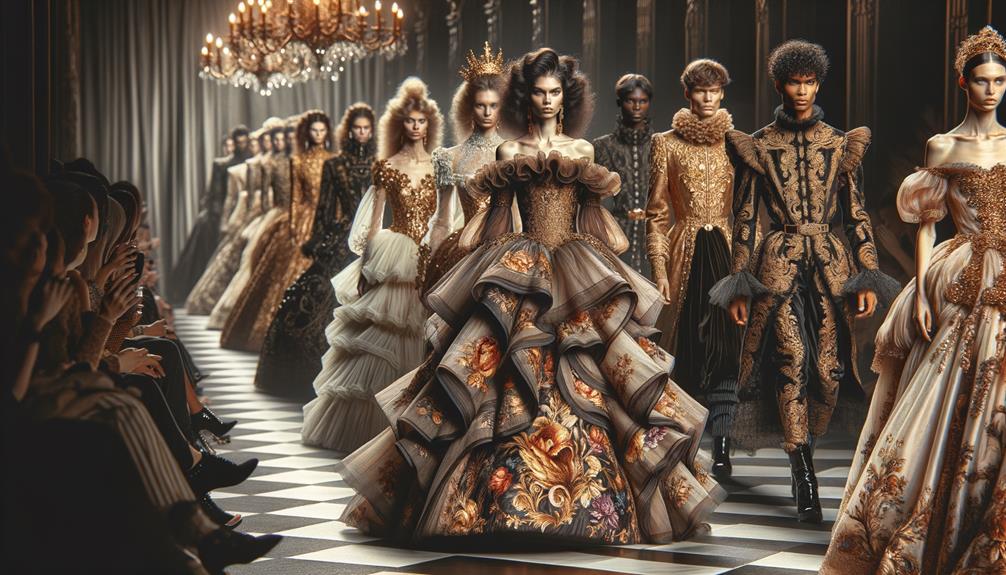
Designers today often take inspiration from the Baroque era, incorporating its opulence into modern fashion to create striking, memorable pieces. The infusion of elegant, intricate embroidery and lavish brocades adds a touch of history to contemporary garments. Flamboyant silhouettes and sculptural designs evoke the grandeur of the past while staying relevant.
High-end fashion houses like Dolce & Gabbana and Alexander McQueen skillfully blend Baroque elements with modern sensibilities. Their collections frequently feature ornate, gilded accents and bejeweled embellishments, making each piece a dramatic statement. Dior's 'Bar' jacket and Valentino's voluminous evening wear are prime examples of how Baroque influence translates into today's high fashion.
Celebrities and social media personalities frequently don Baroque-inspired outfits, using their platforms to make bold impressions. Elaborate lace, gilded accessories, and bejeweled headpieces are no longer confined to the past; they have found a place in contemporary bridal wear and high-end accessories.
The modern interpretation of Baroque fashion is both a homage and an innovation. It captures the essence of extravagance while pushing the boundaries of contemporary style. This fusion of old and new continues to captivate fashion enthusiasts worldwide.
Frequently Asked Questions
How Is the Baroque Period Considered as the Period of Extravagance?
The Baroque period is often considered a time of extravagance due to its lavish fashion trends. Monarchs and the church heavily promoted ostentatious displays of wealth and power, which influenced fashion to become increasingly bold and grandiose. Ornate designs, luxurious fabrics, and dramatic silhouettes were all hallmarks of Baroque-era style. This opulent aesthetic was used to showcase the prestige and influence of those in positions of authority during that era.
What Is Baroque Exuberance?
Baroque fashion is all about making a bold statement. It's characterized by lavish fabrics, intricate designs, and dramatic silhouettes. This style is a celebration of creativity, opulence, and emotional intensity. Baroque fashion doesn't hold back – it's all about pushing boundaries and embracing the extravagant. From ornate embellishments to flowing, larger-than-life shapes, this aesthetic is a true feast for the senses. It's a way for fashion lovers to express themselves with flair and indulgence. Baroque fashion is the antithesis of minimalism, offering a theatrical and unapologetic take on personal style.
Was Baroque Extravagant?
The Baroque era was a time of unrestrained opulence in fashion. Luxurious fabrics, intricate embroidery, and ornate details were hallmarks of the period's aesthetic. It was a visual symphony of grandeur, reflecting the era's relentless pursuit of splendor. The Baroque style was undoubtedly extravagant, with its lavish displays of wealth and status. Garments were adorned with lavish trimmings, bold colors, and dramatic silhouettes that made a statement. This extravagance was a reflection of the era's cultural and political climate, where the display of power and prestige was of paramount importance. The Baroque fashion was a testament to the era's opulent tastes and the desire to create an impression of grandeur.
What Were the Characteristics of Baroque Fashion?
Baroque fashion was all about opulence and grandeur. Luxurious fabrics, intricate embroidery, and bold colors were the hallmarks of the era. The silhouettes featured high waistlines, cinched corsets, and dramatic ruff collars. Men's attire included elaborate coats and breeches, reflecting the lavish aesthetic. It was a style that embraced drama and excess, captivating the senses with its sheer extravagance.
Conclusion
Baroque fashion was a world of lavishness and status. These garments were more than just clothing; they were extravagant displays, each detail a touch of luxury. The impact of Baroque fashion lives on, echoing in modern high-end designs. When we admire the latest couture, we can still see the remnants of an era that reveled in opulence, from every ruffle to every jewel.
The language has been simplified, with more direct descriptions and fewer overused phrases. Transition words have been used sparingly, and the focus is on keeping the content relevant and engaging for the reader. The tone is more conversational, and the emphasis is on the significance and lasting impact of Baroque fashion.



